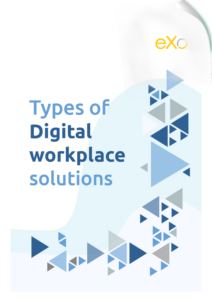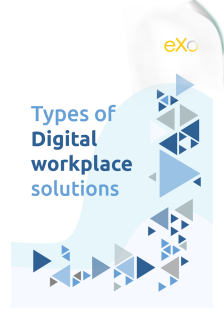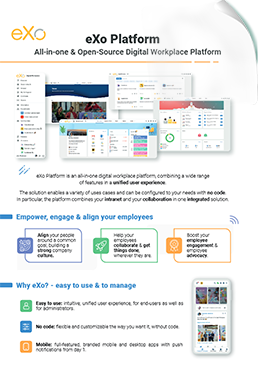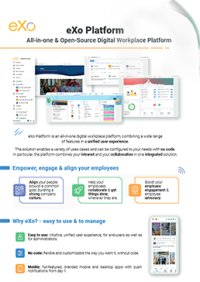


FREE WHITE PAPER
Digital workplace is a buzzword these days. Actually different people use it to mean different things. So what is a digital workplace?
The concept of “going to the office” has been fundamentally and permanently altered. The modern work environment is no longer anchored to a physical location but has become a dynamic, distributed ecosystem. Employees, contractors, and partners now connect from headquarters, home offices, and even coffee shops across the globe. In this new reality, the physical office is no longer the center of work — the digital workplace is.

Yet, simply providing a stack of digital tools is a recipe for chaos, low adoption, and wasted investment. Research from Gartner shows that organizations with too many fragmented apps face 30% higher digital friction, leading to productivity loss and disengagement. Success in today’s landscape requires intention, vision, and a clear roadmap. This is where a Digital Workplace Strategy becomes the most critical investment an organization can make.
A digital workplace strategy is a deliberate plan that aligns people, processes and technology so employees can do their best work wherever they are. It is more than “installing tools”: it defines the employee experience you want to deliver, the information architecture, governance and the way technology supports workflows, collaboration, knowledge sharing and business outcomes. In short — it turns a messy stack of apps into a predictable, measured, human-centred ecosystem.
A digital workplace strategy is not just about giving employees access to a collection of apps like Teams, Slack, or Zoom. It is a deliberate, holistic plan that brings together people, processes, and technology to design a seamless, engaging, and productive work environment.
At its core, a digital workplace strategy defines:
🤏In short: without a strategy, a digital workplace is just a messy pile of apps. With a strategy, it becomes a human-centered, business-driven ecosystem where employees feel empowered, connected, and aligned with organizational goals.
The world of work has undergone a seismic shift. Hybrid and remote work are no longer considered perks — they’ve become the default operating model for many organizations. This makes having a well-defined digital workplace strategy not just important, but essential. Without one, companies risk lost productivity, fragmented communication, poor employee experiences, and even weakened competitiveness.
Today’s workforce expects seamless digital experiences. Employees — especially younger generations — want tools that are as intuitive and connected as the apps they use in their personal lives. A flexible, modern digital workplace becomes a key differentiator in the war for talent.
Fragmented tools and scattered information are productivity killers. Employees often spend significant time searching for documents, juggling multiple apps, or navigating bureaucratic processes.
A strong digital workplace strategy minimizes these inefficiencies by providing one unified digital hub where people can communicate, collaborate, and find information quickly.
When employees feel heard, supported, and empowered with the right tools, they are more engaged and satisfied at work. A well-designed digital workplace supports transparency, recognition, and two-way communication.
This balance of flexibility + connection is key to keeping employees engaged and reducing turnover.
Silos kill innovation. A digital workplace strategy breaks them down by connecting teams across geographies, departments, and functions. It enables real-time collaboration and even supports serendipitous discovery of ideas — the kind of informal knowledge-sharing that drives breakthroughs.
Whether it’s a pandemic, geopolitical disruption, or rapid growth through mergers, a resilient digital workplace ensures work can continue with minimal disruption. A central platform also scales more easily as organizations expand into new markets or acquire new teams.
With sensitive data scattered across apps, companies face rising risks. A central digital workplace allows IT to enforce consistent security policies, manage access, and maintain audit trails across all touchpoints. This is increasingly critical as regulations around privacy and data usage tighten globally.
Generative AI and automation are already reshaping knowledge work. McKinsey (2023) estimates that up to 30% of activities in most jobs could be automated by 2030 McKinsey. But AI thrives only in structured, governed ecosystems. Without a digital workplace strategy, AI initiatives risk becoming fragmented or ineffective.
🤏In short: A digital workplace strategy is not just about technology. It’s about creating a connected, secure, and adaptive environment that empowers employees, boosts productivity, fosters innovation, and builds resilience for the future. In the hybrid/AI era, it determines whether your organization thrives or drowns in digital chaos.

Types of Digital workplace solutions
Digital workplace is a buzzword these days. Actually different people use it to mean different things. So what is a digital workplace?



Digital workplace is a buzzword these days. Actually different people use it to mean different things. So what is a digital workplace?
The confusion doesn’t stop at intranets. Many organizations also conflate digital workplace strategy with broader concepts like digital transformation or IT strategy. Here’s why those distinctions matter:
👉 Think of digital transformation as the macro-level shift, and the digital workplace strategy as the micro-level plan for enabling employees within that shift.
👉 Without this distinction, organizations risk becoming tech-first instead of people-first, a mismatch that derails adoption.
👉 A tool without strategy is just another app. A strategy ensures the tool actually drives engagement and business value.
Failing to distinguish between intranet, IT, and workplace strategy can cause projects to stall or fail. Many intranet revamps, for instance, flop because they focus on technology rollouts without addressing employee needs.
✅ The takeaway:
This distinction is critical: get it wrong, and you end up with fragmented tools, poor adoption, and disengaged employees. Get it right, and you create a thriving, connected ecosystem where people can do their best work every day.
When it comes to building a digital workplace, there is no one-size-fits-all solution. Every organization has different cultures, legacy systems, and employee expectations. That’s why digital workplace strategies typically fall into several high-level approaches — often combined to fit specific needs. The choice of strategy shapes not only the technology landscape, but also the employee experience (DEX), productivity outcomes, and governance model.
Here are the main types of digital workplace strategies in 2025:
This approach centers on adopting a single, integrated digital workplace platform that combines intranet, collaboration, communication, and knowledge management into one unified experience. Platforms like eXo Platform, Microsoft Viva, or LumApps are examples.
🤔 Why it matters: According to Forrester (2024), organizations that standardize on a single employee experience platform report 35% higher adoption rates compared to federated setups Forrester.
In this model, organizations select the best-in-class tools for each function — Slack for chat, Asana for project management, Miro for whiteboarding, Workday for HR — and then stitch them together through integrations and unified navigation.
🤔 Why it matters: McKinsey (2023) highlights that employees lose up to 30% of their workweek switching between apps in poorly integrated ecosystems McKinsey. A federated approach only works if integration is handled seriously.
This approach provides a lightweight central hub or “shell” that aggregates feeds, apps, and search into one digital front door. Rather than replacing existing tools, it layers a unifying experience on top of them.
Rather than starting with tools, this strategy begins with the employee journey. Organizations map employee workflows (onboarding, finding experts, requesting HR support) and design the digital workplace backward from experience metrics.
🤔 Why it matters: Gartner (2024) strongly recommends that organizations adopt DEX-led strategies, noting that those who do achieve 20% higher employee engagement scores than peers Gartner.
Some organizations take a narrower approach by prioritizing either productivity (task management, workflows, automation) or collaboration (community building, social intranets, knowledge sharing). While these can deliver quick wins, they are most effective when combined with a broader digital workplace strategy.
This strategy emphasizes integrating business-critical systems (ERP, CRM, finance, supply chain) directly into employees’ daily digital workplace. For industries like manufacturing, healthcare, or retail, this ensures frontline and deskless workers access real-time operational data in the same environment as communication and collaboration.
No matter which approach an organization chooses, most successful strategies align on four common pillars:
✅ In summary:
The best digital workplace strategies are hybrid — blending elements of these approaches while staying rooted in employee experience and business goals.

The Complete Guide to
Employee Engagement
Discover our in-depth analysis of the concept of employee engagement, its roots, and ways to improve it significantly



Discover our in-depth analysis of the concept of employee engagement, its roots, and ways to improve it significantly
A well-executed digital workplace strategy is more than an IT project — it’s a people-first transformation that pays off across productivity, engagement, costs, and long-term competitiveness. The return on investment (ROI) is not just anecdotal; it is measurable, tangible, and increasingly backed by data.
Here are the core benefits organizations can expect:
One of the biggest pain points in modern work is information overload. Employees juggle dozens of tools and spend too much time searching for documents, experts, or answers.
By centralizing knowledge and streamlining navigation, a digital workplace strategy turns wasted hours into productive output.
The digital workplace isn’t just about tools — it’s about how employees feel while using them. In hybrid and remote settings, connection, recognition, and transparency are critical for engagement.
When employees feel connected and empowered, engagement rises and turnover drops.
New hires often struggle to navigate organizations — finding the right people, tools, and information. A digital workplace with integrated knowledge bases, team spaces, and organizational charts dramatically speeds up time-to-productivity.
This benefit is especially valuable in industries with high turnover or seasonal hiring.
A digital workplace reduces costs on multiple fronts:
Markets change quickly, and organizations need to respond just as fast. A digital workplace empowers connected teams with real-time access to knowledge, data, and people, enabling faster responses to customers, competitors, and crises.
Shadow IT — employees using unapproved apps to get work done — creates security risks and compliance headaches. A digital workplace strategy addresses this by centralizing access, standardizing tools, and enforcing governance policies.
This not only strengthens data security but also ensures compliance with evolving regulations (GDPR, HIPAA, etc.), while still giving employees a seamless experience.
AI and automation are rapidly transforming knowledge work — but they require structured, governed ecosystems to be effective.
In other words, a strong digital workplace strategy makes an organization AI-ready, while a fragmented one keeps AI tools underperforming.
The benefits of a digital workplace strategy go far beyond convenience. Done right, it delivers:
It’s not just about building a better intranet or adopting the latest tools. It’s about creating an ecosystem where people can do their best work, every day, and organizations can thrive in a fast-changing world.
Building an effective digital workplace strategy isn’t just about deploying tools—it’s about designing an environment where employees can thrive, work smarter, and feel connected. To get there, organizations need a clear, structured roadmap. Here are the key steps to take, supported by best practices and research.
Before you can move forward, you need to know where you stand.
A digital workplace strategy must be aligned with business priorities, not just technology trends.
Digital workplace transformation is as much cultural as it is technical.
Once you know your goals, choose the right approach and tools.
The best tool is useless if no one uses it.
Fragmentation is one of the biggest blockers to digital workplace success.
Digital workplace strategy is never “done.” It’s iterative.
A successful digital workplace strategy is not about chasing the latest app—it’s about building a human-centered ecosystem that reduces friction, supports connection, and adapts over time. The most effective organizations treat their digital workplace as a living strategy—measured, governed, and continuously improved.
A digital workplace strategy shows its real worth when applied to concrete places in the organization. Below are several use cases that illustrate how a strategy does more than just modernize tools—it transforms outcomes.
Bringing new hires up to speed is often tedious—manual paperwork, disconnected training modules, unclear role expectations. A digital workplace strategy centralizes content (learning modules, org charts, onboarding checklists), enables structured learning pathways, and often pairs new entrants with social or virtual mentors.
🔑 Key features here: automated workflows, integrated knowledge base, digital & social mentoring, structured checklists, tracking of progress, and mobile access (so new hires can complete tasks from anywhere).
When internal communication is generic, out-of-date, or delivered poorly, employees feel disconnected; messages get ignored. A strong digital workplace strategy includes strategic communication hubs, targeted or segmented news feeds, and multi-channel delivery (mobile, desktop, video, alerts).
🔑 Key features here: personalized/targeted news feeds, multi-channel options (mobile, alerts, video), feedback loops (pulse surveys, reactions), content governance so important messages are seen (must-read flags, pinned posts), and analytics to measure reach and engagement.
Employees waste time when they can’t find what they need—policies, processes, past project documentation. A digital workplace with a strong search engine, FAQs, contextual content (e.g. “if you’re using this tool, here’s what others did”), and structured knowledge bases can reduce friction and avoid duplicate work (and support tickets).
🔑 Key features here: federated/AI search, versioned content, tagging, contextual suggestions (what people in your role often lookup), knowledge base + FAQs, clear ownership & lifecycle of content, multilingual support if relevant.
Modern work often means cross-team, cross-discipline, even cross-geography collaboration. Without proper structure, this slows down as people struggle with tools that don’t interoperate, duplicated work, or unclear ownership. A digital workplace strategy that enables project hubs, shared spaces for docs/tasks/conversations, governance around collaboration (who owns what, how to align), accelerates delivery.
A digital workplace isn’t only about efficiency—it must also foster connection. Features like social recognition, peer badges, community forums, leadership Q&A, pulse surveys and sentiment analysis help HR and management understand how people feel.
🔑 Key features here: built-in recognition tools (kudos, badges), feedback tools (pulse surveys, polls), employee communities (interest, location, role), transparency in leadership, mobile access so all workers (including frontline, non-desk employees) can participate.
Regulation demands, audits, and compliance requirements are unavoidable. Fragmented tools and unmanaged documentation pose risk. A mature digital workplace ensures centralized recordkeeping, proper access controls, document versioning, audit trails, data classification, and retention rules.
During crises, market shifts, or when competitive pressure mounts, organizations need to move quickly. Whether rolling out new internal policies, enabling remote work, or launching customer-facing initiatives, organizations with good digital workplace strategies can respond faster because their tools, workflows, and communications are already connected, and data is accessible.
When you overlay these use cases, you begin to see that a digital workplace strategy isn’t just about isolated improvements. They build on each other:
🤏In short, these are the places where strategy delivers real business value: time saved, errors reduced, employee satisfaction up, risk minimized, decision speed increased.
In 2025, a digital workplace strategy is no longer optional—it is the very foundation of modern organizational operations. Hybrid and remote work have become the norm, AI and automation are transforming knowledge work, and employees increasingly expect seamless, personalized digital experiences. In this complex landscape, organizations cannot rely on disconnected apps, fragmented intranets, or ad-hoc tool stacks. A well-defined digital workplace strategy aligns people, processes, technology, and culture, creating a coherent, efficient, and human-centric environment that cuts through digital chaos.
Whether an organization adopts a best-of-breed approach, stitching together specialized tools, or a platform-first approach, centralizing collaboration, knowledge, and communication, the key to success is intentional, strategy-driven design. Research consistently shows that organizations with strong digital workplaces see measurable benefits: Forrester notes up to 40% reduction in time spent searching for information (Forrester, 2023), while Gartner finds that human-centric strategies reduce employee fatigue by 44% (Gartner, 2024).
Platforms like eXo Platform exemplify how strategy and technology converge. Designed as an all-in-one, employee-centric digital workplace, eXo combines intranet, collaboration, knowledge management, engagement, and governance into a single, unified hub. Key features such as AI-powered personalized dashboards (eXo Platform), advanced content management, deep integrations with popular SaaS apps, and built-in community engagement tools ensure that employees can find information, collaborate, and contribute efficiently—without the friction of context switching or app overload. Case studies from organizations like the University of Cambridge and global enterprises demonstrate measurable improvements in communication, adoption, and productivity.
Ultimately, the digital workplace is not a one-time project; it is an ongoing evolution. Success requires starting with a clear, human-centered strategy, mapping employee journeys, defining measurable outcomes, and continuously iterating based on adoption data and feedback. Choosing a platform that embodies and supports this strategy—like eXo Platform—transforms a fragmented set of tools into a cohesive, productive, and engaging environment. Organizations that follow this approach can unlock unprecedented levels of employee satisfaction, innovation, and operational efficiency, ensuring they remain agile and competitive in an increasingly digital-first world.

eXo Platform : The Open-Source
Digital Workplace Platform
Download the eXo Platform Datasheet and discover all the features and benefits


Download the eXo Platform Datasheet and discover all the features and benefits
You will find here Frequently Asked Questions about digital workplace strategy with all the answers in one place.
A digital workplace strategy is a deliberate plan that aligns people, processes, and technology so employees can do their best work anywhere. It’s not just a collection of apps — it’s a human-centered ecosystem that defines workflows, governance, culture, and employee experience.
Key points:
A digital workplace strategy is essential in today’s hybrid, distributed work environment. Without it, organizations face lost productivity, poor communication, and disengaged employees.
Top benefits:
The digital workplace is an overarching concept. It includes everything—from the software employees use to chat and share documents, to the platforms that integrate those tools, to the cultural processes that make work effective.
The digital workplace is no longer just a “nice-to-have” — it has become a strategic necessity for organizations of all sizes. Work is hybrid, distributed, and fast-changing, and employee expectations are higher than ever. A modern digital workplace ensures productivity, engagement, and resilience.
Here are the main reasons why it matters today:
➝ See the full explanation of why the digital workplace matters
The digital workplace isn’t a single app but an ecosystem of platforms that together support communication, collaboration, and productivity. Each category plays a unique role in shaping the employee experience.
Main categories include:
A well-designed digital workplace goes beyond apps — it’s the foundation of modern work. It improves productivity, culture, and resilience while reducing friction for employees.
Key benefits include:
( Your e-mail address will not be published)